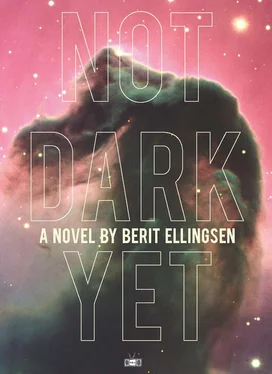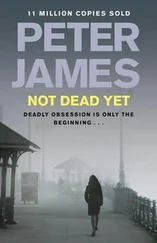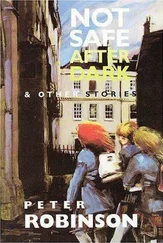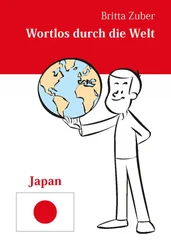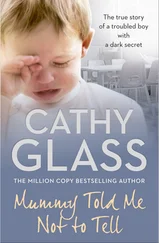“Local ones?”
“From all over the world, but raised in captivity. Their wild cousins should be allowed to remain wild. These were saved from an aviary that had to close. They were born in captivity and couldn’t be released without extensive training and care.”
“What happened?” he said. “Lack of visitors?”
“A fire, a rather sudden one,” Kaye said. “The park had a history of mistreating their birds. But the owls are happy now, that’s what matters.”
“Of course,” he said.
Kaye continued to describe the owls, how the various species and their hearing differed and what significance that had for what type of prey they took and their rate of success.
He turned toward the other cages. “All I know about owls is that they’re nocturnal.”
“They’re mostly active at night,” Kaye said. “Or when they perceive it’s night, and that’s when they usually hunt. But one or two species do hunt during the day if they need to, and they all do if the situation presents itself.”
By the door to the next room hung a calendar with handwritten notes in red, blue, green, and black. The assistant professor leaned close to inspect it. “The owls have been outside today, but not fed their evening meal yet,” Kaye said, “so I can show you that.”
“Do you need me to do anything?” he said.
“Just watch. Think of it as introducing yourself, your voice and motions.”
“Can they tell the difference between us?”
“Of course,” Kaye said. “They are able to hear a mouse running through the underbrush in complete darkness with such accuracy that all they need to do is fly over and scoop it up with their talons.”
“Soundlessly?” he said.
“Completely silent to us because of how their wings and tail are constructed,” Kaye said. “They have to, since their prey is not only running, but also listening for its life.”
“Amazing,” he said.
“Isn’t it?” Kaye said and gave him a broad smile.
The assistant professor returned to the room they just left. There he pulled out two laboratory gloves from a box and put them on. Then he took one of the mouse cages down from the rack and placed it on the counter. Inside the plastic several lumps of brown fur were visible in the wood wool.
Can’t just feed one of the owls,” Kaye said, “or the rest of them won’t calm down for hours.”
“Do they become envious of each other?” he asked.
“Who knows,” Kaye said. “At least they can tell when someone else is getting something they don’t and they dislike it. And why shouldn’t they be capable of feeling envy, even if they are birds? They’re intelligent enough to thaw food that’s frozen over with the heat from their own bodies. Many animals seem to experience the same emotions as we do, joy, fear, anger, desire, and so on. Some even mourn their dead when they encounter a corpse of their own species.”
“Really? I had no idea.”
The assistant professor searched his face for a moment. “Sorry, I’m lecturing,” Kaye said. “It’s a bad habit, but almost unavoidable in academia.”
“No, please go on.”
“It seems that most, if not all, of our emotional responses are older than humanity,” Kaye continued, a look of child-like eagerness on his face. “Much of what we think makes us human actually pre-dates us, our tools, and our civilization. We inherited love and altruism from our evolutionary forebears, those traits did not originate in human beings.
“Humanity is eradicating the habitats of millions of species, with several hundred going extinct each day. We’ve set off a new mass extinction, on a scale that’s only happened five times before on the planet. Our hunger for non-renewable energy, cheap consumer goods, and endless economic growth is making the same impact on the environment as an asteroid would. Even worse, the large earth systems may be so destabilized that several aspects of climate change are now irreversible. It’s impossible to say which wild animals or plants will survive under these conditions.”
He looked at the assistant professor, not certain how to respond.
“Well, that concludes tonight’s class,” Kaye smiled. “Shall we get to work?”

Kaye carried the box of mice into the owl room and continued to the uppermost cage in the corner furthest from the door. The mottled gray bird that sat inside turned its head toward them and blinked, but did not otherwise move or make a sound. The assistant professor pushed one hand beneath the plastic lid of the mouse box and picked up one of the round forms that was sleeping inside the scuffed world. The mouse stirred only a little. With the other hand, Kaye slid the small latch of the owl cage aside, opened the door, and placed the mouse inside. In the new and unfamiliar environment the mouse kept to the walls of the enclosure and nearly vanished in the deep wood wool. The owl stretched its neck and moved its head from side to side. Then the bird hopped down almost nonchalantly and landed right on top of the mouse. The tiny mammal squeaked more loudly than its size indicated it was capable of and began to struggle intensely, but that could not save it from the owl’s talons. The owl picked the mouse up with its beak and flapped back to the perch. There it tilted its head, snapped its mandibles a few times to orient the prey, stretched its neck, and devoured the mouse whole. The owl swallowed a few more times, shook its feathers, then closed its large yellow eyes. The other birds were hooting, turning their heads, and beating their wings so feathers and wood wool swirled inside the cages.
“Don’t worry,” Kaye said. “We do have a special permit to feed the owls live mice.”
He nodded. He had seen worse, of course he had, but he couldn’t tell that to a stranger.
“I’d better finish this before all of them start shouting,” Kaye said. The assistant professor continued to the next enclosure, dipped his hand into the mouse box, opened the latch, dropped a mouse inside, shut the wire door, then progressed to the next owl. As the birds spotted the mice, they fell silent, and chased and ate their prey.
“They don’t receive the food for free though,” Kaye said after he had fetched a second box of mice and fed all the owls. The assistant professor crossed the bird room and opened the door in the back. “This is where they earn their meals.”
The room inside was square, about five by five meters, and lit by small, strong spotlights. The walls as well as the ceiling were paneled in a blue plastic material that was smooth and soft to the touch. The floor was covered with the same wood wool as the mouse boxes and owl cages. On the other side of the room was a rectangular mirror and a narrow door. In the center of the blue space stood an emaciated and nearly leafless birch tree. Gray and yellow droppings streaked the few branches that the tree possessed.
That’s the problem with birds, he thought. They shit everywhere, even where they sleep.
Along the floor triangular sheets of green paper with white marker at the summits had been taped on the plastic surface. A few paper trees had also been glued to the walls to further mimic a place in the mountains, without making the illusion any more convincing. Instead, it looked like a rubber room for owls.
“We’ve tried to make it a little more homey for the birds,” Kaye said, as if guessing his reaction. “But we haven’t got much leeway because of the soundproofing and the microphone setup.”
He nodded.
The assistant professor strode across the wood wool and unlocked the narrow door in the back. When he switched on the light inside, the mirror became a window. The small space was filled with two blond desks set at a right angle from each other, bounding a cluster of office chairs. The desks carried monitors, computer keyboards, and sound recording consoles, reminding him of the music studio Beanie worked at in the city center.
Читать дальше
